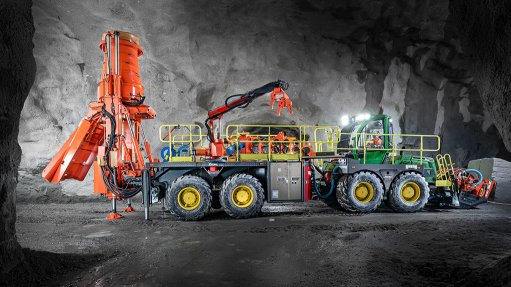
The Rhino 100 ‘plug-and-drill’ raiseborer from Sandvik Mining & Rock Solutions
Recently introduced to the Southern African market, two ‘plug-and-drill’ raiseborers are soon to be delivered to local mining sites.
The primary application of the Rhino 100 raiseborers from Sandvik Mining & Rock Solutions is for drilling of production slots, but can also be used in a range of other applications – from ventilation raises and escape routes to ore passes and connections between tunnels.
“Using conventional drill and blast methods, these vertical or inclined holes can take mines three to six months to complete,” says Sandvik Mining & Rock Solutions business line manager for underground drilling in Southern Africa Saltiel Pule. “With the Rhino 100, we are talking about durations of less than a week.”
Drilled relief holes in sub-level open stoping slot raises provides the necessary void space for blasting, allowing the expansion of blasted rock into the void to improve fragmentation, says Sandvik Mining & Rock Solutions sales engineer for underground drilling Dean Zharare, explaining that the conventional blasting of slot raises often creates a bottleneck for mines.
“We have encountered situations where mine personnel have to return two or three times to a slot raise before it is ready, due to misfires, for instance,” says Zharare. “This creates a bottleneck in the mining process, reducing the monthly metres achieved.”
The mobility and drilling speed of the Rhino 100 can transform this scenario, he says, with an expectation that monthly metres drilled could be improved by 65%. There is even the possibility that a unit could be operated remotely with the operator based on surface while it drills underground stopes.
Drilling holes of 750 mm in diameter, the raiseborer boasts penetration rates of about 2 m an hour, more than double the rate of conventional methods. As important as the speed, he says, is the reliability of the result.
“These larger holes make the blast much more reliable, avoiding any time consuming and dangerous redrilling in the event of a block ‘freezing’ after an unsuccessful blast,” he says.
The machine’s mobility is further improved by its ability to carry its own components, including rods, cables, hydraulics and the raiseboring head – all pulled by a specially adapted double-axle John Deere tractor. To optimise the set-up time, which is said to take approximately 10 minutes, it has outriggers for stability and does not need a specially-poured concrete pad. An inclinometer gives the operator the necessary coordinates for a surveyor to confirm before drilling operations begin, eliminating the need for roof bolting.